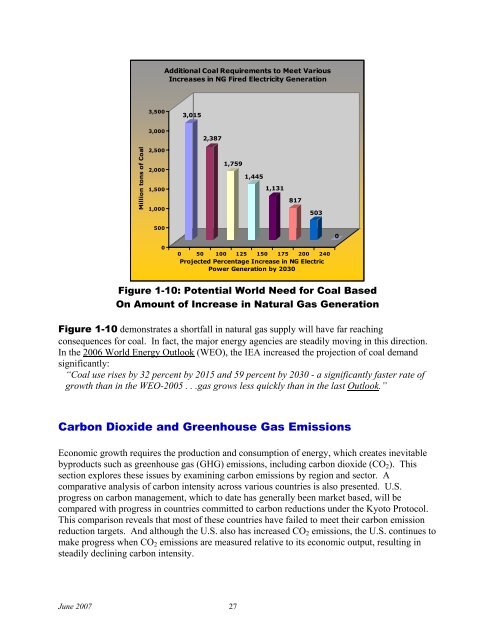Technologies to Reduce or Capture and Store Carbon Dioxide Emissions
TECHNOLOgIEs to Reduce or Capture and store Carbon Dioxide ...
TECHNOLOgIEs to Reduce or Capture and store Carbon Dioxide ...
You also want an ePaper? Increase the reach of your titles
YUMPU automatically turns print PDFs into web optimized ePapers that Google loves.
Additional Coal Requirements <strong>to</strong> Meet Various<br />
Increases in NG Fired Electricity Generation<br />
3,500<br />
3,015<br />
3,000<br />
2,387<br />
Million <strong>to</strong>ns of Coal<br />
2,500<br />
2,000<br />
1,500<br />
1,000<br />
1,759<br />
1,445<br />
1,131<br />
817<br />
503<br />
500<br />
0<br />
0<br />
0 50 100 125 150 175 200 240<br />
Projected Percentage Increase in NG Electric<br />
Power Generation by 2030<br />
Figure 1-10: Potential W<strong>or</strong>ld Need f<strong>or</strong> Coal Based<br />
On Amount of Increase in Natural Gas Generation<br />
Figure 1-10 demonstrates a sh<strong>or</strong>tfall in natural gas supply will have far reaching<br />
consequences f<strong>or</strong> coal. In fact, the maj<strong>or</strong> energy agencies are steadily moving in this direction.<br />
In the 2006 W<strong>or</strong>ld Energy Outlook (WEO), the IEA increased the projection of coal dem<strong>and</strong><br />
significantly:<br />
“Coal use rises by 32 percent by 2015 <strong>and</strong> 59 percent by 2030 - a significantly faster rate of<br />
growth than in the WEO-2005 . . .gas grows less quickly than in the last Outlook.”<br />
<strong>Carbon</strong> <strong>Dioxide</strong> <strong>and</strong> Greenhouse Gas <strong>Emissions</strong><br />
Economic growth requires the production <strong>and</strong> consumption of energy, which creates inevitable<br />
byproducts such as greenhouse gas (GHG) emissions, including carbon dioxide (CO 2 ). This<br />
section expl<strong>or</strong>es these issues by examining carbon emissions by region <strong>and</strong> sec<strong>to</strong>r. A<br />
comparative analysis of carbon intensity across various countries is also presented. U.S.<br />
progress on carbon management, which <strong>to</strong> date has generally been market based, will be<br />
compared with progress in countries committed <strong>to</strong> carbon reductions under the Kyo<strong>to</strong> Pro<strong>to</strong>col.<br />
This comparison reveals that most of these countries have failed <strong>to</strong> meet their carbon emission<br />
reduction targets. And although the U.S. also has increased CO 2 emissions, the U.S. continues <strong>to</strong><br />
make progress when CO 2 emissions are measured relative <strong>to</strong> its economic output, resulting in<br />
steadily declining carbon intensity.<br />
June 2007 27


